Variations in Health IV: Culture's Impact on Pain Management
VerifiedAdded on 2023/06/10
|9
|2451
|337
Essay
AI Summary
This essay explores the multifaceted nature of pain, encompassing physical discomfort and emotional distress, and highlights the significant influence of culture on pain perception, response, and management. It discusses how pain can arise from physical damage, diseases, diagnoses, and treatments, while also acknowledging the emotional pain associated with life's challenges. The essay emphasizes the relationship between ethnicity and pain, demonstrating how cultural backgrounds shape individual perceptions and responses to pain. Focusing on the Punjabi ethnic group as an example, it suggests culturally sensitive nursing interventions, such as utilizing non-verbal pain assessment tools and incorporating traditional medicine practices, to provide effective and personalized care. The essay concludes by stressing the importance of nurses being aware of their own biases and cultural influences to deliver culturally safe and patient-centered pain management.
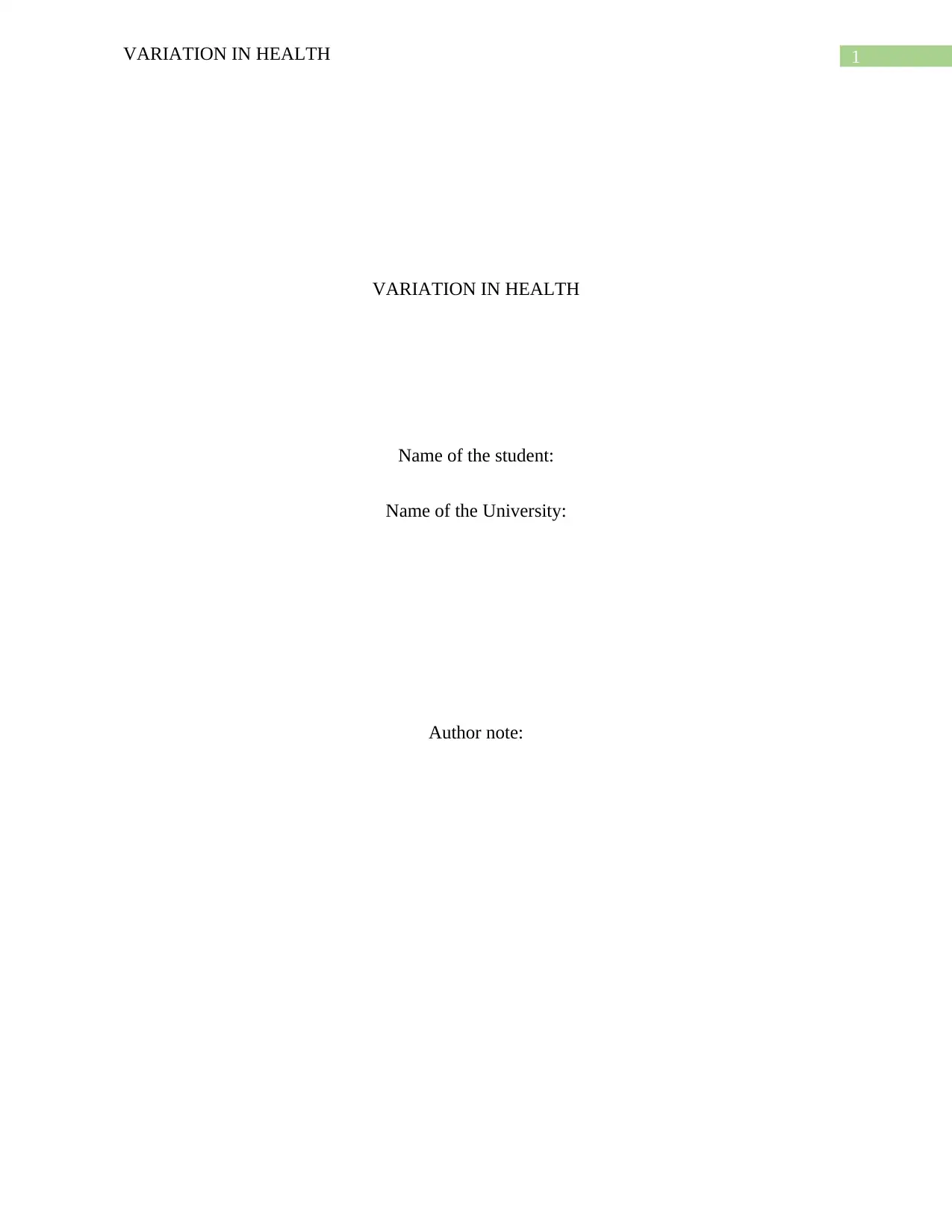
1VARIATION IN HEALTH
VARIATION IN HEALTH
Name of the student:
Name of the University:
Author note:
VARIATION IN HEALTH
Name of the student:
Name of the University:
Author note:
Paraphrase This Document
Need a fresh take? Get an instant paraphrase of this document with our AI Paraphraser
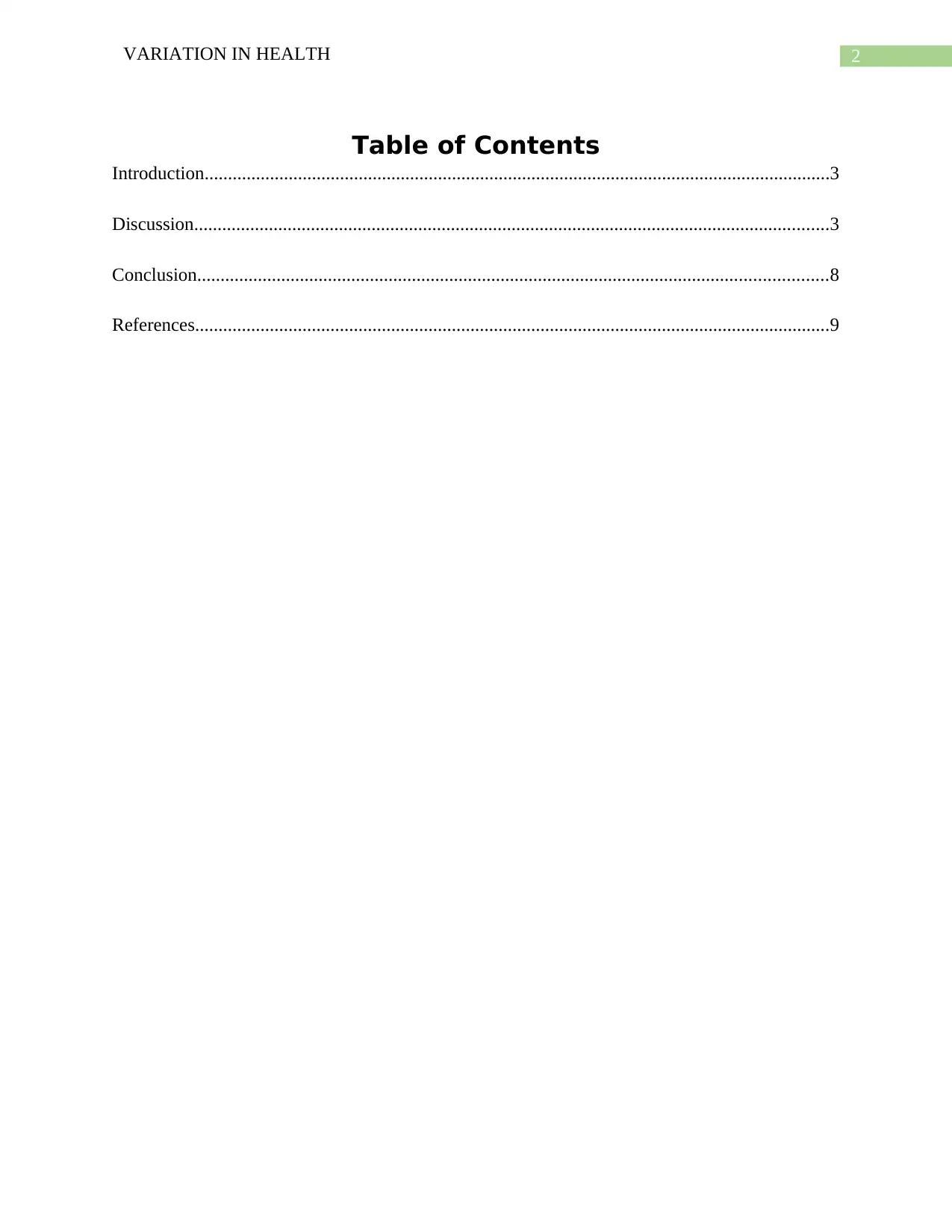
2VARIATION IN HEALTH
Table of Contents
Introduction......................................................................................................................................3
Discussion........................................................................................................................................3
Conclusion.......................................................................................................................................8
References........................................................................................................................................9
Table of Contents
Introduction......................................................................................................................................3
Discussion........................................................................................................................................3
Conclusion.......................................................................................................................................8
References........................................................................................................................................9
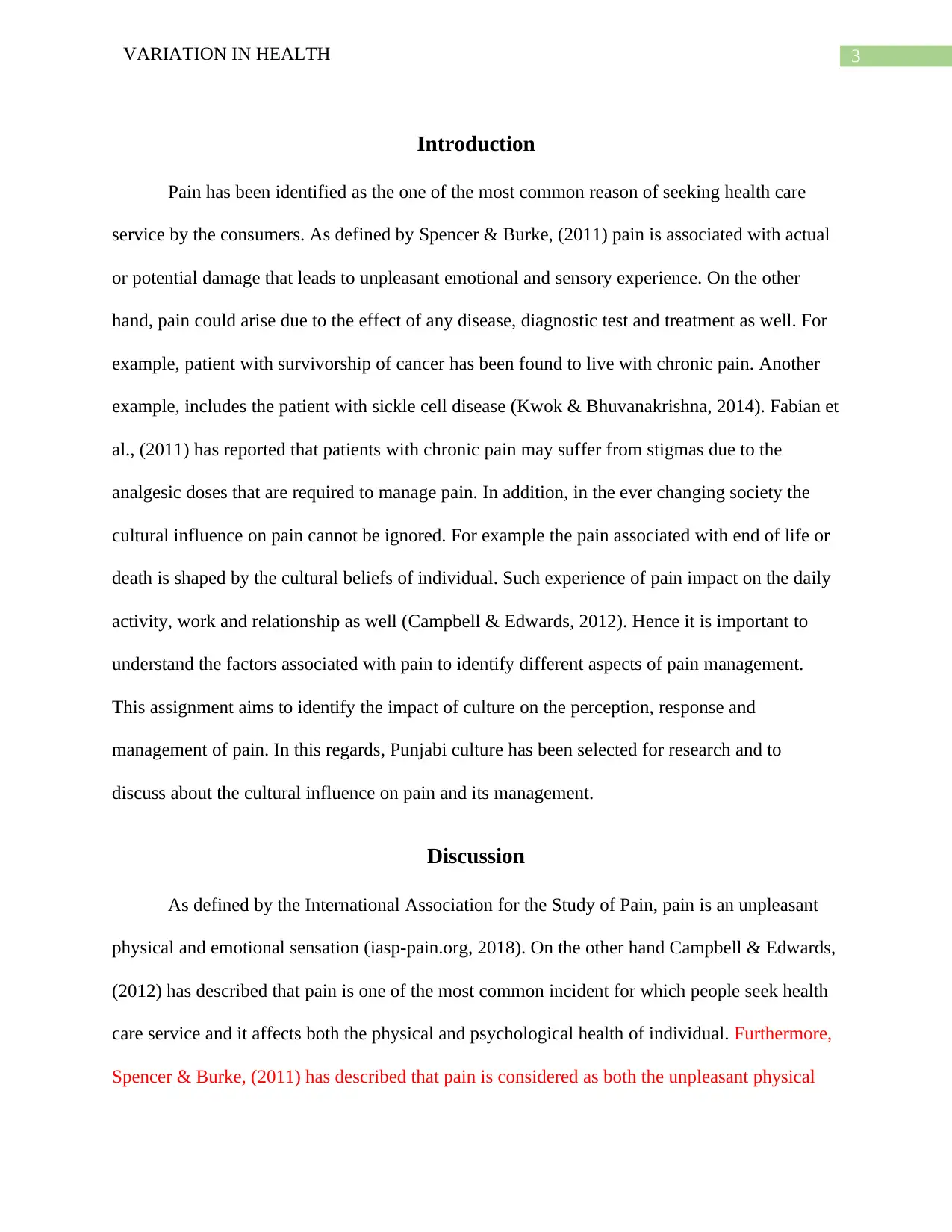
3VARIATION IN HEALTH
Introduction
Pain has been identified as the one of the most common reason of seeking health care
service by the consumers. As defined by Spencer & Burke, (2011) pain is associated with actual
or potential damage that leads to unpleasant emotional and sensory experience. On the other
hand, pain could arise due to the effect of any disease, diagnostic test and treatment as well. For
example, patient with survivorship of cancer has been found to live with chronic pain. Another
example, includes the patient with sickle cell disease (Kwok & Bhuvanakrishna, 2014). Fabian et
al., (2011) has reported that patients with chronic pain may suffer from stigmas due to the
analgesic doses that are required to manage pain. In addition, in the ever changing society the
cultural influence on pain cannot be ignored. For example the pain associated with end of life or
death is shaped by the cultural beliefs of individual. Such experience of pain impact on the daily
activity, work and relationship as well (Campbell & Edwards, 2012). Hence it is important to
understand the factors associated with pain to identify different aspects of pain management.
This assignment aims to identify the impact of culture on the perception, response and
management of pain. In this regards, Punjabi culture has been selected for research and to
discuss about the cultural influence on pain and its management.
Discussion
As defined by the International Association for the Study of Pain, pain is an unpleasant
physical and emotional sensation (iasp-pain.org, 2018). On the other hand Campbell & Edwards,
(2012) has described that pain is one of the most common incident for which people seek health
care service and it affects both the physical and psychological health of individual. Furthermore,
Spencer & Burke, (2011) has described that pain is considered as both the unpleasant physical
Introduction
Pain has been identified as the one of the most common reason of seeking health care
service by the consumers. As defined by Spencer & Burke, (2011) pain is associated with actual
or potential damage that leads to unpleasant emotional and sensory experience. On the other
hand, pain could arise due to the effect of any disease, diagnostic test and treatment as well. For
example, patient with survivorship of cancer has been found to live with chronic pain. Another
example, includes the patient with sickle cell disease (Kwok & Bhuvanakrishna, 2014). Fabian et
al., (2011) has reported that patients with chronic pain may suffer from stigmas due to the
analgesic doses that are required to manage pain. In addition, in the ever changing society the
cultural influence on pain cannot be ignored. For example the pain associated with end of life or
death is shaped by the cultural beliefs of individual. Such experience of pain impact on the daily
activity, work and relationship as well (Campbell & Edwards, 2012). Hence it is important to
understand the factors associated with pain to identify different aspects of pain management.
This assignment aims to identify the impact of culture on the perception, response and
management of pain. In this regards, Punjabi culture has been selected for research and to
discuss about the cultural influence on pain and its management.
Discussion
As defined by the International Association for the Study of Pain, pain is an unpleasant
physical and emotional sensation (iasp-pain.org, 2018). On the other hand Campbell & Edwards,
(2012) has described that pain is one of the most common incident for which people seek health
care service and it affects both the physical and psychological health of individual. Furthermore,
Spencer & Burke, (2011) has described that pain is considered as both the unpleasant physical
⊘ This is a preview!⊘
Do you want full access?
Subscribe today to unlock all pages.

Trusted by 1+ million students worldwide
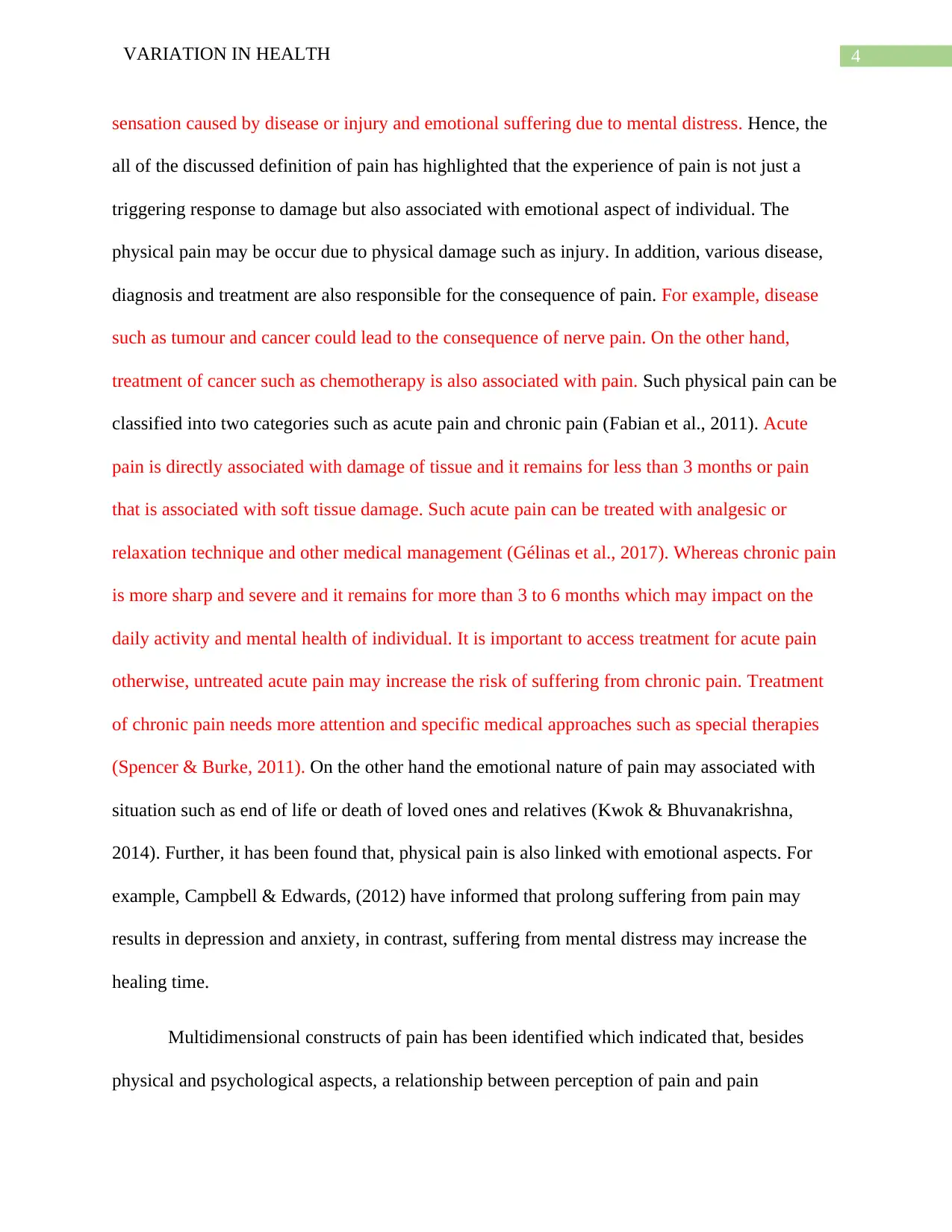
4VARIATION IN HEALTH
sensation caused by disease or injury and emotional suffering due to mental distress. Hence, the
all of the discussed definition of pain has highlighted that the experience of pain is not just a
triggering response to damage but also associated with emotional aspect of individual. The
physical pain may be occur due to physical damage such as injury. In addition, various disease,
diagnosis and treatment are also responsible for the consequence of pain. For example, disease
such as tumour and cancer could lead to the consequence of nerve pain. On the other hand,
treatment of cancer such as chemotherapy is also associated with pain. Such physical pain can be
classified into two categories such as acute pain and chronic pain (Fabian et al., 2011). Acute
pain is directly associated with damage of tissue and it remains for less than 3 months or pain
that is associated with soft tissue damage. Such acute pain can be treated with analgesic or
relaxation technique and other medical management (Gélinas et al., 2017). Whereas chronic pain
is more sharp and severe and it remains for more than 3 to 6 months which may impact on the
daily activity and mental health of individual. It is important to access treatment for acute pain
otherwise, untreated acute pain may increase the risk of suffering from chronic pain. Treatment
of chronic pain needs more attention and specific medical approaches such as special therapies
(Spencer & Burke, 2011). On the other hand the emotional nature of pain may associated with
situation such as end of life or death of loved ones and relatives (Kwok & Bhuvanakrishna,
2014). Further, it has been found that, physical pain is also linked with emotional aspects. For
example, Campbell & Edwards, (2012) have informed that prolong suffering from pain may
results in depression and anxiety, in contrast, suffering from mental distress may increase the
healing time.
Multidimensional constructs of pain has been identified which indicated that, besides
physical and psychological aspects, a relationship between perception of pain and pain
sensation caused by disease or injury and emotional suffering due to mental distress. Hence, the
all of the discussed definition of pain has highlighted that the experience of pain is not just a
triggering response to damage but also associated with emotional aspect of individual. The
physical pain may be occur due to physical damage such as injury. In addition, various disease,
diagnosis and treatment are also responsible for the consequence of pain. For example, disease
such as tumour and cancer could lead to the consequence of nerve pain. On the other hand,
treatment of cancer such as chemotherapy is also associated with pain. Such physical pain can be
classified into two categories such as acute pain and chronic pain (Fabian et al., 2011). Acute
pain is directly associated with damage of tissue and it remains for less than 3 months or pain
that is associated with soft tissue damage. Such acute pain can be treated with analgesic or
relaxation technique and other medical management (Gélinas et al., 2017). Whereas chronic pain
is more sharp and severe and it remains for more than 3 to 6 months which may impact on the
daily activity and mental health of individual. It is important to access treatment for acute pain
otherwise, untreated acute pain may increase the risk of suffering from chronic pain. Treatment
of chronic pain needs more attention and specific medical approaches such as special therapies
(Spencer & Burke, 2011). On the other hand the emotional nature of pain may associated with
situation such as end of life or death of loved ones and relatives (Kwok & Bhuvanakrishna,
2014). Further, it has been found that, physical pain is also linked with emotional aspects. For
example, Campbell & Edwards, (2012) have informed that prolong suffering from pain may
results in depression and anxiety, in contrast, suffering from mental distress may increase the
healing time.
Multidimensional constructs of pain has been identified which indicated that, besides
physical and psychological aspects, a relationship between perception of pain and pain
Paraphrase This Document
Need a fresh take? Get an instant paraphrase of this document with our AI Paraphraser
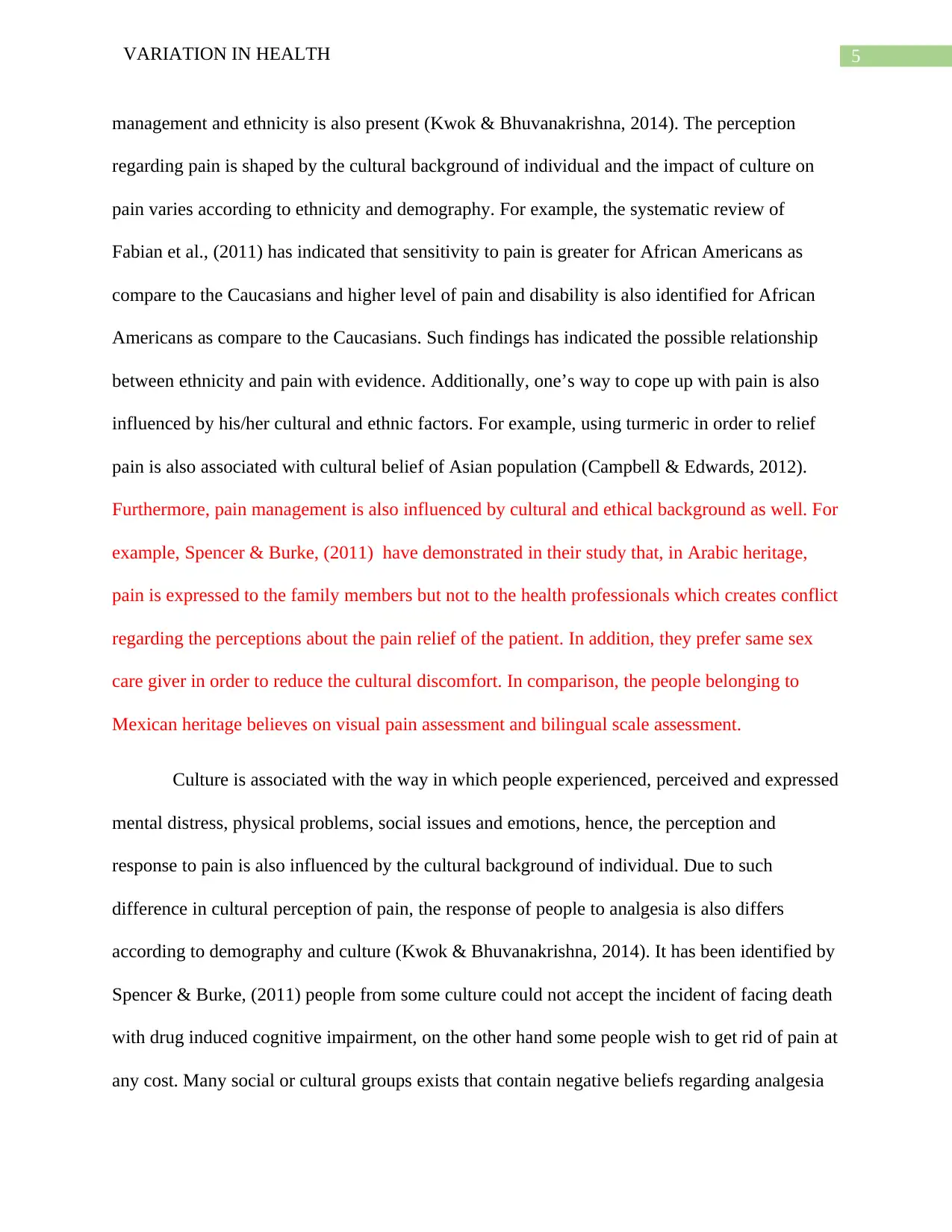
5VARIATION IN HEALTH
management and ethnicity is also present (Kwok & Bhuvanakrishna, 2014). The perception
regarding pain is shaped by the cultural background of individual and the impact of culture on
pain varies according to ethnicity and demography. For example, the systematic review of
Fabian et al., (2011) has indicated that sensitivity to pain is greater for African Americans as
compare to the Caucasians and higher level of pain and disability is also identified for African
Americans as compare to the Caucasians. Such findings has indicated the possible relationship
between ethnicity and pain with evidence. Additionally, one’s way to cope up with pain is also
influenced by his/her cultural and ethnic factors. For example, using turmeric in order to relief
pain is also associated with cultural belief of Asian population (Campbell & Edwards, 2012).
Furthermore, pain management is also influenced by cultural and ethical background as well. For
example, Spencer & Burke, (2011) have demonstrated in their study that, in Arabic heritage,
pain is expressed to the family members but not to the health professionals which creates conflict
regarding the perceptions about the pain relief of the patient. In addition, they prefer same sex
care giver in order to reduce the cultural discomfort. In comparison, the people belonging to
Mexican heritage believes on visual pain assessment and bilingual scale assessment.
Culture is associated with the way in which people experienced, perceived and expressed
mental distress, physical problems, social issues and emotions, hence, the perception and
response to pain is also influenced by the cultural background of individual. Due to such
difference in cultural perception of pain, the response of people to analgesia is also differs
according to demography and culture (Kwok & Bhuvanakrishna, 2014). It has been identified by
Spencer & Burke, (2011) people from some culture could not accept the incident of facing death
with drug induced cognitive impairment, on the other hand some people wish to get rid of pain at
any cost. Many social or cultural groups exists that contain negative beliefs regarding analgesia
management and ethnicity is also present (Kwok & Bhuvanakrishna, 2014). The perception
regarding pain is shaped by the cultural background of individual and the impact of culture on
pain varies according to ethnicity and demography. For example, the systematic review of
Fabian et al., (2011) has indicated that sensitivity to pain is greater for African Americans as
compare to the Caucasians and higher level of pain and disability is also identified for African
Americans as compare to the Caucasians. Such findings has indicated the possible relationship
between ethnicity and pain with evidence. Additionally, one’s way to cope up with pain is also
influenced by his/her cultural and ethnic factors. For example, using turmeric in order to relief
pain is also associated with cultural belief of Asian population (Campbell & Edwards, 2012).
Furthermore, pain management is also influenced by cultural and ethical background as well. For
example, Spencer & Burke, (2011) have demonstrated in their study that, in Arabic heritage,
pain is expressed to the family members but not to the health professionals which creates conflict
regarding the perceptions about the pain relief of the patient. In addition, they prefer same sex
care giver in order to reduce the cultural discomfort. In comparison, the people belonging to
Mexican heritage believes on visual pain assessment and bilingual scale assessment.
Culture is associated with the way in which people experienced, perceived and expressed
mental distress, physical problems, social issues and emotions, hence, the perception and
response to pain is also influenced by the cultural background of individual. Due to such
difference in cultural perception of pain, the response of people to analgesia is also differs
according to demography and culture (Kwok & Bhuvanakrishna, 2014). It has been identified by
Spencer & Burke, (2011) people from some culture could not accept the incident of facing death
with drug induced cognitive impairment, on the other hand some people wish to get rid of pain at
any cost. Many social or cultural groups exists that contain negative beliefs regarding analgesia
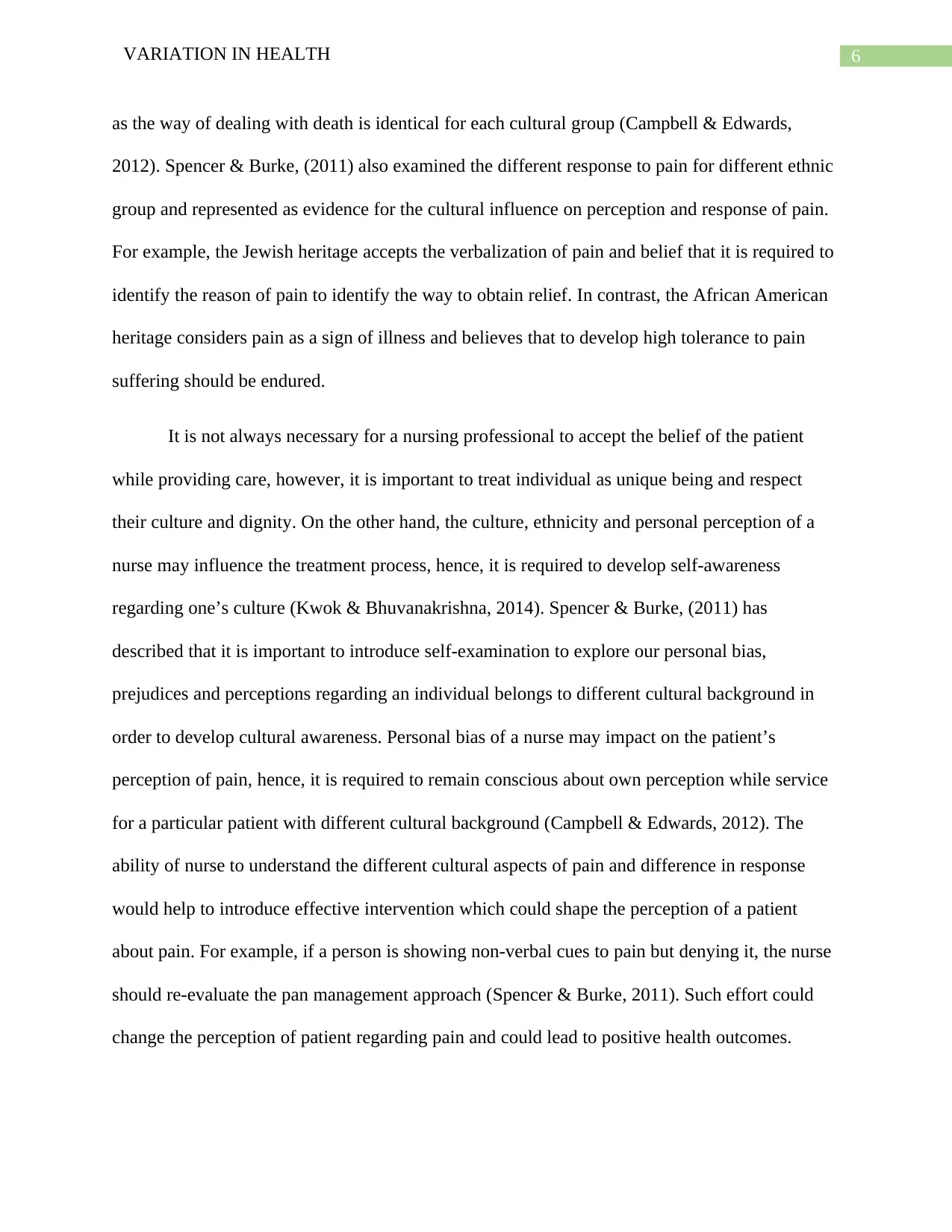
6VARIATION IN HEALTH
as the way of dealing with death is identical for each cultural group (Campbell & Edwards,
2012). Spencer & Burke, (2011) also examined the different response to pain for different ethnic
group and represented as evidence for the cultural influence on perception and response of pain.
For example, the Jewish heritage accepts the verbalization of pain and belief that it is required to
identify the reason of pain to identify the way to obtain relief. In contrast, the African American
heritage considers pain as a sign of illness and believes that to develop high tolerance to pain
suffering should be endured.
It is not always necessary for a nursing professional to accept the belief of the patient
while providing care, however, it is important to treat individual as unique being and respect
their culture and dignity. On the other hand, the culture, ethnicity and personal perception of a
nurse may influence the treatment process, hence, it is required to develop self-awareness
regarding one’s culture (Kwok & Bhuvanakrishna, 2014). Spencer & Burke, (2011) has
described that it is important to introduce self-examination to explore our personal bias,
prejudices and perceptions regarding an individual belongs to different cultural background in
order to develop cultural awareness. Personal bias of a nurse may impact on the patient’s
perception of pain, hence, it is required to remain conscious about own perception while service
for a particular patient with different cultural background (Campbell & Edwards, 2012). The
ability of nurse to understand the different cultural aspects of pain and difference in response
would help to introduce effective intervention which could shape the perception of a patient
about pain. For example, if a person is showing non-verbal cues to pain but denying it, the nurse
should re-evaluate the pan management approach (Spencer & Burke, 2011). Such effort could
change the perception of patient regarding pain and could lead to positive health outcomes.
as the way of dealing with death is identical for each cultural group (Campbell & Edwards,
2012). Spencer & Burke, (2011) also examined the different response to pain for different ethnic
group and represented as evidence for the cultural influence on perception and response of pain.
For example, the Jewish heritage accepts the verbalization of pain and belief that it is required to
identify the reason of pain to identify the way to obtain relief. In contrast, the African American
heritage considers pain as a sign of illness and believes that to develop high tolerance to pain
suffering should be endured.
It is not always necessary for a nursing professional to accept the belief of the patient
while providing care, however, it is important to treat individual as unique being and respect
their culture and dignity. On the other hand, the culture, ethnicity and personal perception of a
nurse may influence the treatment process, hence, it is required to develop self-awareness
regarding one’s culture (Kwok & Bhuvanakrishna, 2014). Spencer & Burke, (2011) has
described that it is important to introduce self-examination to explore our personal bias,
prejudices and perceptions regarding an individual belongs to different cultural background in
order to develop cultural awareness. Personal bias of a nurse may impact on the patient’s
perception of pain, hence, it is required to remain conscious about own perception while service
for a particular patient with different cultural background (Campbell & Edwards, 2012). The
ability of nurse to understand the different cultural aspects of pain and difference in response
would help to introduce effective intervention which could shape the perception of a patient
about pain. For example, if a person is showing non-verbal cues to pain but denying it, the nurse
should re-evaluate the pan management approach (Spencer & Burke, 2011). Such effort could
change the perception of patient regarding pain and could lead to positive health outcomes.
⊘ This is a preview!⊘
Do you want full access?
Subscribe today to unlock all pages.

Trusted by 1+ million students worldwide
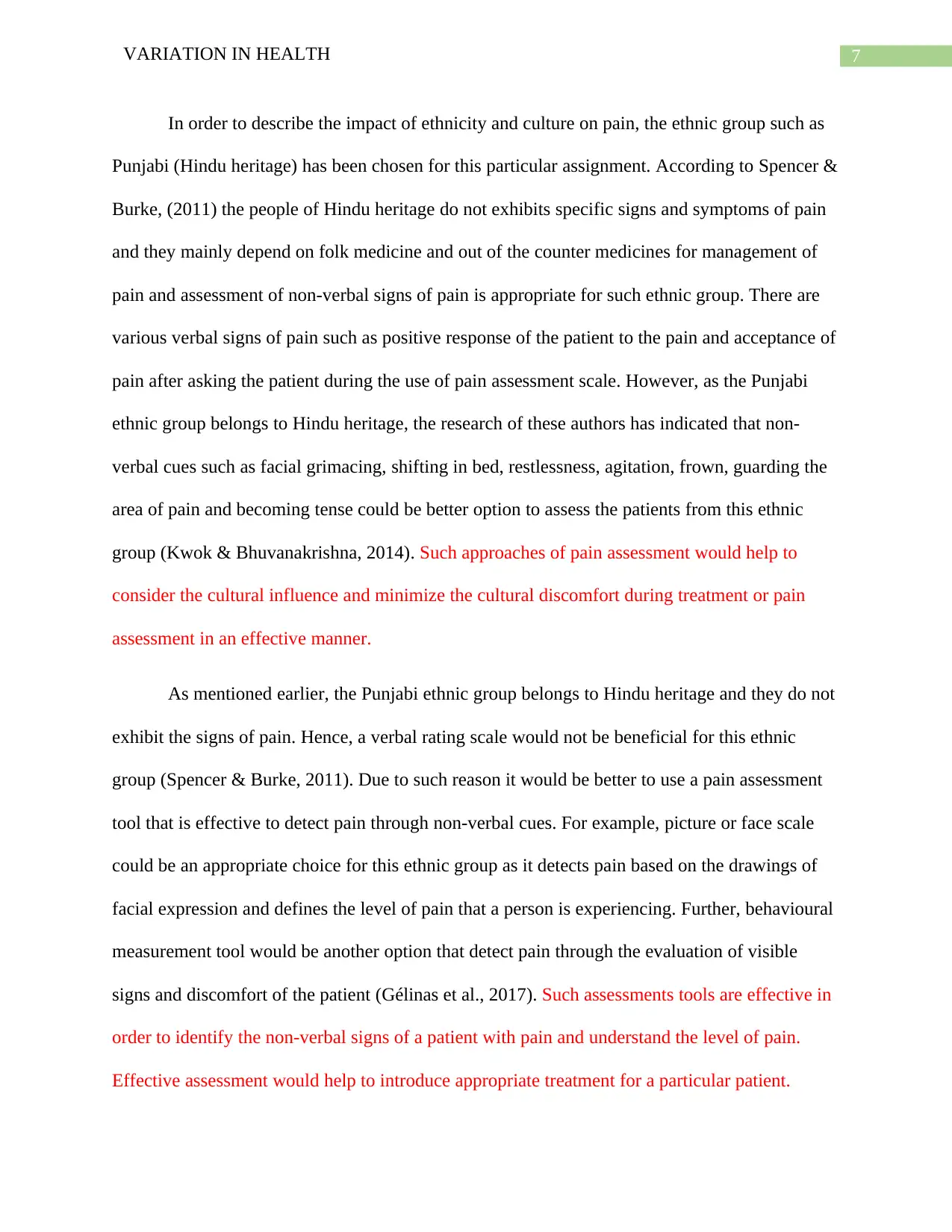
7VARIATION IN HEALTH
In order to describe the impact of ethnicity and culture on pain, the ethnic group such as
Punjabi (Hindu heritage) has been chosen for this particular assignment. According to Spencer &
Burke, (2011) the people of Hindu heritage do not exhibits specific signs and symptoms of pain
and they mainly depend on folk medicine and out of the counter medicines for management of
pain and assessment of non-verbal signs of pain is appropriate for such ethnic group. There are
various verbal signs of pain such as positive response of the patient to the pain and acceptance of
pain after asking the patient during the use of pain assessment scale. However, as the Punjabi
ethnic group belongs to Hindu heritage, the research of these authors has indicated that non-
verbal cues such as facial grimacing, shifting in bed, restlessness, agitation, frown, guarding the
area of pain and becoming tense could be better option to assess the patients from this ethnic
group (Kwok & Bhuvanakrishna, 2014). Such approaches of pain assessment would help to
consider the cultural influence and minimize the cultural discomfort during treatment or pain
assessment in an effective manner.
As mentioned earlier, the Punjabi ethnic group belongs to Hindu heritage and they do not
exhibit the signs of pain. Hence, a verbal rating scale would not be beneficial for this ethnic
group (Spencer & Burke, 2011). Due to such reason it would be better to use a pain assessment
tool that is effective to detect pain through non-verbal cues. For example, picture or face scale
could be an appropriate choice for this ethnic group as it detects pain based on the drawings of
facial expression and defines the level of pain that a person is experiencing. Further, behavioural
measurement tool would be another option that detect pain through the evaluation of visible
signs and discomfort of the patient (Gélinas et al., 2017). Such assessments tools are effective in
order to identify the non-verbal signs of a patient with pain and understand the level of pain.
Effective assessment would help to introduce appropriate treatment for a particular patient.
In order to describe the impact of ethnicity and culture on pain, the ethnic group such as
Punjabi (Hindu heritage) has been chosen for this particular assignment. According to Spencer &
Burke, (2011) the people of Hindu heritage do not exhibits specific signs and symptoms of pain
and they mainly depend on folk medicine and out of the counter medicines for management of
pain and assessment of non-verbal signs of pain is appropriate for such ethnic group. There are
various verbal signs of pain such as positive response of the patient to the pain and acceptance of
pain after asking the patient during the use of pain assessment scale. However, as the Punjabi
ethnic group belongs to Hindu heritage, the research of these authors has indicated that non-
verbal cues such as facial grimacing, shifting in bed, restlessness, agitation, frown, guarding the
area of pain and becoming tense could be better option to assess the patients from this ethnic
group (Kwok & Bhuvanakrishna, 2014). Such approaches of pain assessment would help to
consider the cultural influence and minimize the cultural discomfort during treatment or pain
assessment in an effective manner.
As mentioned earlier, the Punjabi ethnic group belongs to Hindu heritage and they do not
exhibit the signs of pain. Hence, a verbal rating scale would not be beneficial for this ethnic
group (Spencer & Burke, 2011). Due to such reason it would be better to use a pain assessment
tool that is effective to detect pain through non-verbal cues. For example, picture or face scale
could be an appropriate choice for this ethnic group as it detects pain based on the drawings of
facial expression and defines the level of pain that a person is experiencing. Further, behavioural
measurement tool would be another option that detect pain through the evaluation of visible
signs and discomfort of the patient (Gélinas et al., 2017). Such assessments tools are effective in
order to identify the non-verbal signs of a patient with pain and understand the level of pain.
Effective assessment would help to introduce appropriate treatment for a particular patient.
Paraphrase This Document
Need a fresh take? Get an instant paraphrase of this document with our AI Paraphraser
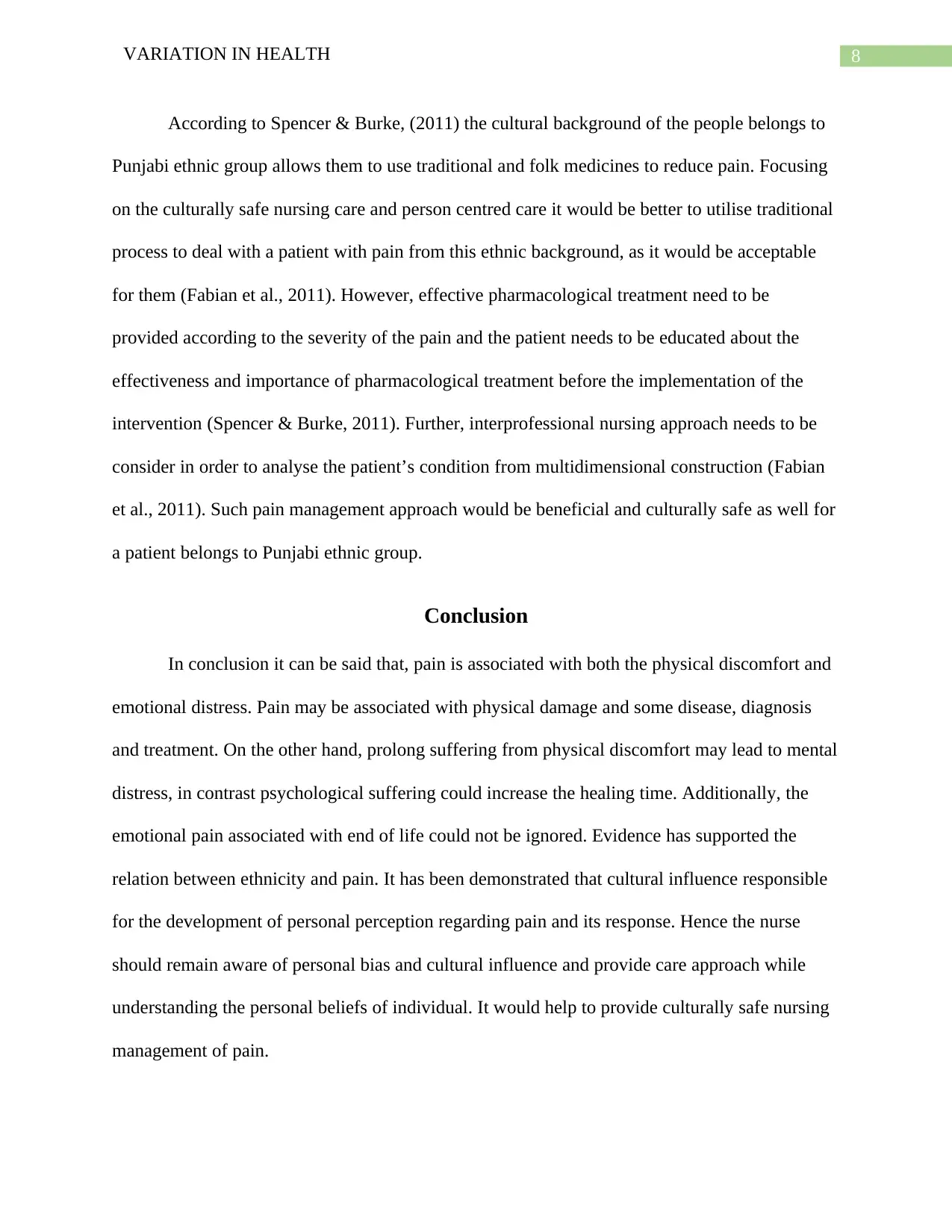
8VARIATION IN HEALTH
According to Spencer & Burke, (2011) the cultural background of the people belongs to
Punjabi ethnic group allows them to use traditional and folk medicines to reduce pain. Focusing
on the culturally safe nursing care and person centred care it would be better to utilise traditional
process to deal with a patient with pain from this ethnic background, as it would be acceptable
for them (Fabian et al., 2011). However, effective pharmacological treatment need to be
provided according to the severity of the pain and the patient needs to be educated about the
effectiveness and importance of pharmacological treatment before the implementation of the
intervention (Spencer & Burke, 2011). Further, interprofessional nursing approach needs to be
consider in order to analyse the patient’s condition from multidimensional construction (Fabian
et al., 2011). Such pain management approach would be beneficial and culturally safe as well for
a patient belongs to Punjabi ethnic group.
Conclusion
In conclusion it can be said that, pain is associated with both the physical discomfort and
emotional distress. Pain may be associated with physical damage and some disease, diagnosis
and treatment. On the other hand, prolong suffering from physical discomfort may lead to mental
distress, in contrast psychological suffering could increase the healing time. Additionally, the
emotional pain associated with end of life could not be ignored. Evidence has supported the
relation between ethnicity and pain. It has been demonstrated that cultural influence responsible
for the development of personal perception regarding pain and its response. Hence the nurse
should remain aware of personal bias and cultural influence and provide care approach while
understanding the personal beliefs of individual. It would help to provide culturally safe nursing
management of pain.
According to Spencer & Burke, (2011) the cultural background of the people belongs to
Punjabi ethnic group allows them to use traditional and folk medicines to reduce pain. Focusing
on the culturally safe nursing care and person centred care it would be better to utilise traditional
process to deal with a patient with pain from this ethnic background, as it would be acceptable
for them (Fabian et al., 2011). However, effective pharmacological treatment need to be
provided according to the severity of the pain and the patient needs to be educated about the
effectiveness and importance of pharmacological treatment before the implementation of the
intervention (Spencer & Burke, 2011). Further, interprofessional nursing approach needs to be
consider in order to analyse the patient’s condition from multidimensional construction (Fabian
et al., 2011). Such pain management approach would be beneficial and culturally safe as well for
a patient belongs to Punjabi ethnic group.
Conclusion
In conclusion it can be said that, pain is associated with both the physical discomfort and
emotional distress. Pain may be associated with physical damage and some disease, diagnosis
and treatment. On the other hand, prolong suffering from physical discomfort may lead to mental
distress, in contrast psychological suffering could increase the healing time. Additionally, the
emotional pain associated with end of life could not be ignored. Evidence has supported the
relation between ethnicity and pain. It has been demonstrated that cultural influence responsible
for the development of personal perception regarding pain and its response. Hence the nurse
should remain aware of personal bias and cultural influence and provide care approach while
understanding the personal beliefs of individual. It would help to provide culturally safe nursing
management of pain.
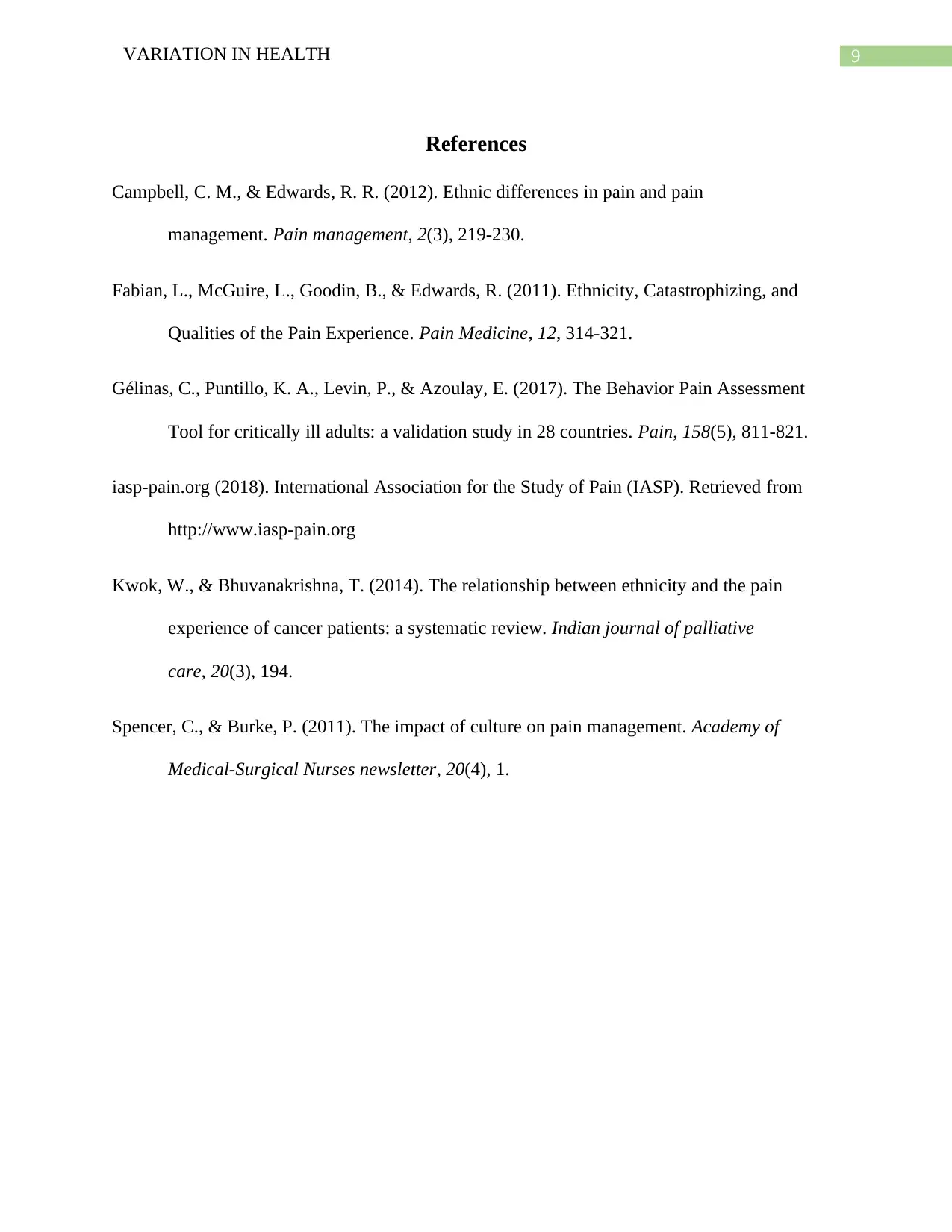
9VARIATION IN HEALTH
References
Campbell, C. M., & Edwards, R. R. (2012). Ethnic differences in pain and pain
management. Pain management, 2(3), 219-230.
Fabian, L., McGuire, L., Goodin, B., & Edwards, R. (2011). Ethnicity, Catastrophizing, and
Qualities of the Pain Experience. Pain Medicine, 12, 314-321.
Gélinas, C., Puntillo, K. A., Levin, P., & Azoulay, E. (2017). The Behavior Pain Assessment
Tool for critically ill adults: a validation study in 28 countries. Pain, 158(5), 811-821.
iasp-pain.org (2018). International Association for the Study of Pain (IASP). Retrieved from
http://www.iasp-pain.org
Kwok, W., & Bhuvanakrishna, T. (2014). The relationship between ethnicity and the pain
experience of cancer patients: a systematic review. Indian journal of palliative
care, 20(3), 194.
Spencer, C., & Burke, P. (2011). The impact of culture on pain management. Academy of
Medical-Surgical Nurses newsletter, 20(4), 1.
References
Campbell, C. M., & Edwards, R. R. (2012). Ethnic differences in pain and pain
management. Pain management, 2(3), 219-230.
Fabian, L., McGuire, L., Goodin, B., & Edwards, R. (2011). Ethnicity, Catastrophizing, and
Qualities of the Pain Experience. Pain Medicine, 12, 314-321.
Gélinas, C., Puntillo, K. A., Levin, P., & Azoulay, E. (2017). The Behavior Pain Assessment
Tool for critically ill adults: a validation study in 28 countries. Pain, 158(5), 811-821.
iasp-pain.org (2018). International Association for the Study of Pain (IASP). Retrieved from
http://www.iasp-pain.org
Kwok, W., & Bhuvanakrishna, T. (2014). The relationship between ethnicity and the pain
experience of cancer patients: a systematic review. Indian journal of palliative
care, 20(3), 194.
Spencer, C., & Burke, P. (2011). The impact of culture on pain management. Academy of
Medical-Surgical Nurses newsletter, 20(4), 1.
⊘ This is a preview!⊘
Do you want full access?
Subscribe today to unlock all pages.

Trusted by 1+ million students worldwide
1 out of 9
Related Documents
Your All-in-One AI-Powered Toolkit for Academic Success.
+13062052269
info@desklib.com
Available 24*7 on WhatsApp / Email
![[object Object]](/_next/static/media/star-bottom.7253800d.svg)
Unlock your academic potential
Copyright © 2020–2025 A2Z Services. All Rights Reserved. Developed and managed by ZUCOL.





